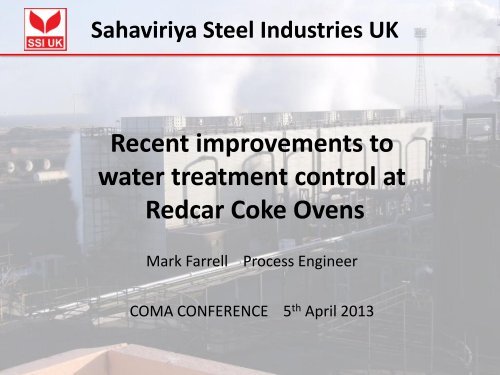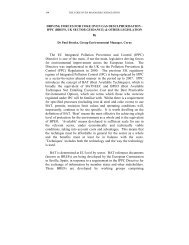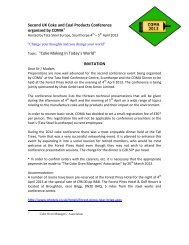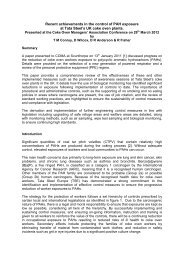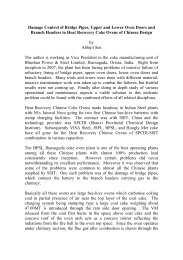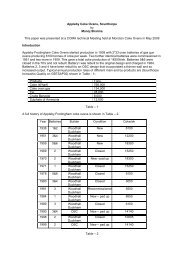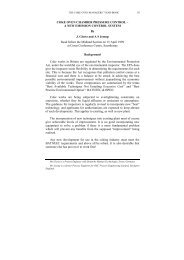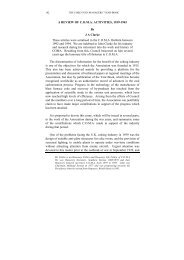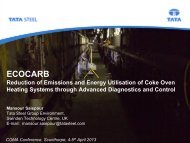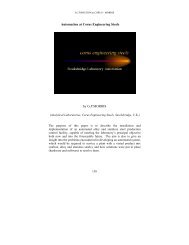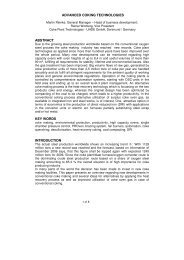Controller Unit - Coke Oven Managers Association
Controller Unit - Coke Oven Managers Association
Controller Unit - Coke Oven Managers Association
You also want an ePaper? Increase the reach of your titles
YUMPU automatically turns print PDFs into web optimized ePapers that Google loves.
Sahaviriya Steel Industries UKRecent improvements towater treatment control atRedcar <strong>Coke</strong> <strong>Oven</strong>sMark Farrell Process EngineerCOMA CONFERENCE 5 th April 2013
Presentation agendaIndustrial cooling system• Cooling tower system principles• Site users of cooling water• True cost of running cooling tower• Common problems of cooling water systemsEffect on operations• Case studies and associated costsImplementation of treatment program• Reasons for installation, the approach• Total Cost of Operation (TCO)• System set up• <strong>Controller</strong> unit• Monitoring & Alarm managementIPPC (BAT)Summary2
Industrial cooling systemApril 13 3
Cooling water usersNH3 washersSecondary cooling HENH3 RecycleLiqour coolerPrimaryCooler LiqourHEBTX coolersNaptha VapourCoolerExhauster oilcoolerFree NH3PHEStripped oilcoolerFixed & FreeNH3 PHEPrimarycooler Pumpoil coolerWash oilcoolersDividing tankcooling coilGas Boosteroil coolersApril 13 4
True cost of running cooling towerApril 13 5
Problems in cooling water systemsContaminants enter the system either through the makeupwater or from the air via the cooling tower.As the cooling water evaporates, contaminants are allowed toconcentrate in the system.If left untreated, high concentrations of impurities can lead to anumber of serious problems, classified into four key areas:1. Corrosion2. Scale3. Fouling4. Biological contaminationApril 13 6
CASE STUDYA) PRIMARY COOLINGThe hot liquor from the primarycooler passes through 10 spiralheat exchangers.The cooling of the liquor was notsufficient due to scale formation.Levels of 35 o C for several months.7
Associated Operational CostsCASE STUDYProcessing gas volume• Gas volume increased into exhauster, increasing RPM.• Power demand increase at exhauster shaft = circa £ 80, 000 p.aReduced Naphthalene removal• Overloading main washer.• Naphthalene carryover tounder firing system.• Naphthalene condenses in gas mains.• Several months continuous cleaning= £ 130, 000 for labour.April 13 9
CASE STUDYB) NH3 vapour plate heat exchangersThe ammonia vapour from the fixed andfree NH3 stills and free NH3 stills passesthrough PHE (5-off), for cooling beforeincineration.Due to high temperatures, scale formationis prevalent if cooling water chemistrydrifts.Levels of 90 o C for several months. (Aim of 85 o C)10
CASE STUDYAssociated operational costsFrequent plant shut down• Heat exchangers need cleaning offsite, every turnaround.Incineration performance• Increased water content in vapour to incinerator.• Additional fuel (COG) required = circa £ 60, 000 p.a.Stack Emissions• Increase in Nox, NH3 stack emissions.April 13 11
CASE STUDYTighter pH control neededLangelier Saturation indexEquilibrium modelIndication: saturation of waterwith respect to CaCO3.Ammonia PHEStep change from 85 o C to 91-94 o C,across all 5 unitsFactors: Alkalinity, Ca hardness,TDS, pH & temperatureLSI: Step change -0.2 to 1.2April 13 12
TREATMENT PROGRAMTreatment program installationMakeup hardness variation is common.Tighter biocide addition desired.Tighter pH control desired.Equipment reliability is paramount.November 2012• Installation of the Nalco 3D TRASARApril 13 13
TREATMENT PROGRAMThe approach to a successful program1. Optimisation• Optimised chemical treatment and automated system.2. Continuous control and monitoring.3. Key Personnel Training• Understand the value of the cooling water system.• Understand the program.• Commitment to the scheme.All combined reduce the Total Cost of Operation (TCO).April 13 14
TREATMENT PROGRAMApril 13 15
System Set UpImmediate alarmresponse3D TRASAR controller+Nalco 360Expert CenterPerformancereviewsWeb connectionAutomated ReportingApril 13 16
<strong>Controller</strong> <strong>Unit</strong>April 13 17
<strong>Controller</strong> <strong>Unit</strong>1) CONDUCTIVITY (µS/cm)Conductivity is defined as the measurement of electricalconductance due to ionic species being present in the water.As pure water is evaporated, minerals are left behind in therecirculation water.Specified control limits for water conductivity.Diligent blow down management is essential for conductivitycontrol.April 13 18
<strong>Controller</strong> <strong>Unit</strong>2) pH controlThe control of pH is critical for the majority of cooling water treatmentprograms, so an automated feed system is required.Scale formation increases when pH is above recommended ranges.In general metal corrosion rate increases when pH is below recommendedranges.The effectiveness of many biocides depends on the pH.April 13 19
<strong>Controller</strong> <strong>Unit</strong>3) ORP mV (Oxidation Reduction Potential)ORP is a measure of the oxidising properties of the sanitiser inwater.Automated addition of Sodium Hypochlorite.• Ensures the system has enough free chlorine for effectivedisinfection.‘The applied dosage should be sufficient to maintain a free reservein the range of 0.5 -1 mg/l chlorine’. 1)April 13 20
4. Corrosion and Scale InhibitorsCorrosion Inhibition1. To assess or predict corrosion behaviour.2. To relate this information to the operating variables (i.e, pH,temperature, water quality, chemical treatment).Scale Inhibition<strong>Controller</strong> <strong>Unit</strong>1. Scale forming minerals are kept in solution, restricts thecrystallization process.2 . Kinetic inhibitors modify the crystal structure of scales,reducing the speed of growth of the deposit.April 13 21
<strong>Controller</strong> <strong>Unit</strong>April 13 22
<strong>Controller</strong> <strong>Unit</strong>April 13 23
MonitoringMonitoring- Internet access mynalco.com24/7 system monitoring by water treatment professionalsApril 13 24
MonitoringAlarm Troubleshooting• Explanation of problem• Trend graph showing results• Suggested actions to resolveEmail notificationBenefits• Explanation of problem• Trend graph showing results• Suggested actions to resolve• Prioritise urgency of alarm• Take fast appropriate action upon alarm.• Promotes actions to avoid threat to plantApril 13 25
MonitoringORPBefore 3DTrasar,ORP based controlwas erratic.April 13 26
MonitoringpHApril 13 27
The Integrated Pollution Prevention andControl (IPPC) directiveThis project meets the requirements for BAT specified under IPPCfor treatment of industrial cooling systems.1. Reduced demand for natural resourcesThrough increased overall energy efficiency, and reduced water use.BAT - Reduce resistance to heat exchange.BAT - Monitor the degree of fouling and other parameters.BAT - Reduce water use.• Maintain maximum cycles of concentration.• Minimising fresh water demand, conserving water supplies.• TCO Contribution: circa 50, 000 m³ of water per annum + treatmentchemicals costs.April 13 28
Application of Best Available Techniques (BAT)April 13 29
Application of Best Available Techniques (BAT)2. Reduced environmental impact of system operationBAT - Reduce emissions to air.• BAT- Optimise water treatment to control microbes.BAT - Reduce emissions to Water.• BAT - Minimise volume of treatment chemicals& corrosion products.• BAT- Maximise corrosion control,leaks and their impact.• BAT- Optimize chemicalusage through control & monitoring.April 13 • TCO contribution 10% reduction in chemical usage.30
Overall Sustainability ImpactReduces demand for water and energy resources, reducesemissions to air, and ultimately reduces wastewater emissions.Reduced emissions means better air and environmental qualityfor the workforce and the local community.Protects system assets through minimised corrosion, avoidspremature and costly replacement.By lowering demand for local renewable resources this supportssocial sustainability safeguarding public water supplies.April 13 31
SummaryInsight into cooling tower principles and common problems posed towater treatment systems.Plant case studies due to scaling, fouling and drift in water chemistry,with the associated costs to operation.Necessity of a cooling tower water treatment program.Implementation of Nalco 3DTrasar treatment system.Increased plant efficiency, reduce downtime and maintenance costs.Good control meets BAT guidelines in accordance with IPPC.Optimised water and chemical usage.Total Cost of Operation (TCO) substantial savings to be made.TCO contribution will be reviewed bi-annually against projected savings.April 13 32
Thank youQuestionsReferences1) http://www.hse.gov.uk/pubns/books/l8.htm2) http://eippcb.jrc.es/reference/BREF/cvs_bref_1201.pdfNalco: various sourcesApril 13 33


